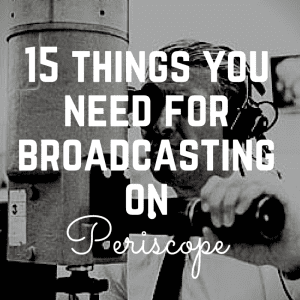 Content publishers and brands are broadcasting real-time video and gaining large audiences using Periscope, Twitter’s new live-streaming video publication tool. As communicators, it’s essential that we know how to use platforms like Periscope (and Meerkat) to good effect, both for the brands we represent and our own learning and development.
Content publishers and brands are broadcasting real-time video and gaining large audiences using Periscope, Twitter’s new live-streaming video publication tool. As communicators, it’s essential that we know how to use platforms like Periscope (and Meerkat) to good effect, both for the brands we represent and our own learning and development.
The use of emerging platforms should always be a component of a healthy integrated marketing mix, (click to tweet) and Periscope can be a great tool for generating awareness and engagement for a host of marketing activities. Your audience wants to be part of your brand activities but, more often than not, can’t be there in person to do so. Here are a few instances in which you may want to consider deploying a Periscope campaign:
- Photo shoots
- Ambassador interviews
- Conferences/panel discussions
- Product demonstrations/reviews
- Shop and retail tours
- Press day access
- Behind the scenes
I’ve been avidly watching and creating my own Periscope broadcasts over the last few weeks and developed the following basic guide of how to use the tool.
Here are my 15 Periscope best practices:
- Have the right equipment—a rig or a tripod, a full battery and a smartphone or tablet with the app installed—if you don’t have the equipment you can find it on Amazon
- Make sure your smartphone is fully charged
- Make sure you have wifi or a 4G connection from the place you will be broadcasting from
- Appropriately title your broadcast
- Have a call to action in the title so people know what to do or ask when they open the broadcast
- Share it socially with your followers and friends
- Be consistent with hashtags and other conversations or broadcasts you are performing at the time
- Hold your smartphone vertically — changing to landscape doesn’t recalibrate the broadcast and you end up with a weird viewing angle
- Use the top 3rd of the screen—commentary will block the view of what’s going on if it’s switched on
- Flip the camera, if you are interviewing yourself or talking to the audience have the camera facing you—if you’re shooting a scene, make sure you flip the camera
- Be aware of mirroring—if you are filming with the front camera, text and other gestures will appear mirrored and make it difficult for the audience to see
- Ask questions of the audience—everyone loves to give their opinion
- Answer questions in real-time to avoid frustration
- Encourage positive feedback by asking your audience to double tap to agree if typing isn’t conducive
- Remember Periscope is a mobile-first application and that your broadcast will be global. With that in mind, you may get unusual questions—luckily you can pause commentary and block offensive users—those pesky trolls are everywhere!
Let me know if you have any more Periscope or Meerkat tips in the comments section below!


